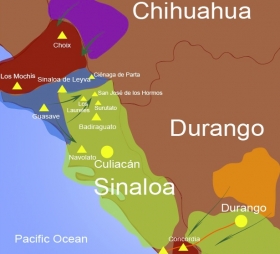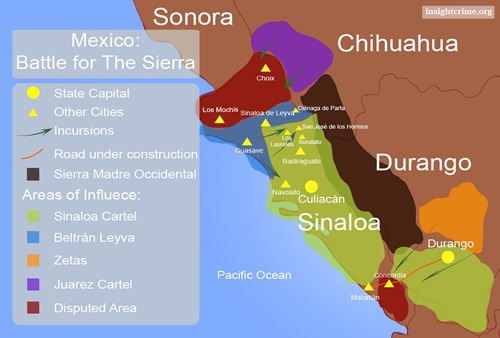A flood of villagers are fleeing their homes in the state of Sinaloa, driven out by a battle between two of the country's biggest criminal organizations -- the Sinaloa Cartel and the Beltran Leyva Organization -- for the crown jewel of Mexico's drug production: the Sierra Madre mountain range.
 In May, the Sinaloa state government released a report (see pdf attachment below) claiming 1,203 families, or an estimated 5,000 people, had been forced to leave their homes in the last several months, but blamed the displacements on both increasing violence in the area and a severe drought. The Sinaloa Human Rights Commission, a non-governmental organization, says the number of displaced in the state is closer to 25,000 people over roughly the same period, the vast majority of whom are fleeing the fighting between drug cartels (.pdf version of commission's annual report available below).
In May, the Sinaloa state government released a report (see pdf attachment below) claiming 1,203 families, or an estimated 5,000 people, had been forced to leave their homes in the last several months, but blamed the displacements on both increasing violence in the area and a severe drought. The Sinaloa Human Rights Commission, a non-governmental organization, says the number of displaced in the state is closer to 25,000 people over roughly the same period, the vast majority of whom are fleeing the fighting between drug cartels (.pdf version of commission's annual report available below).
Both the state and the human rights organization reports agree that the majority of these people come from municipalities in the Sierra Mountains, which cut through the states of Sinaloa, Durango and Chihuahua. This region makes up part of the so-called Golden Triangle, the epicenter of marijuana and poppy (the raw ingredient for heroin) production in the country. Authorities also believe there are large, industrial-size methamphetamine labs in the area.
The Sierra is a symbolic center of operations for the Sinaloa Cartel and the cartel's birthplace. For opposition forces, taking this strategic and symbolic center of operations would represent a seismic shift in the Mexican underworld and may help explain why the Sinaloa cartel forces have targeted the Zetas' stronghold of Nuevo Laredo in recent weeks.
Displaced people, interviewed during a visit to the area by InSight Crime, say that beginning in July of last year caravans of vehicles carrying large groups of heavily armed men have poured into their territory to commit assassinations, burn houses and run them from their villages.
"They say: 'If you stay, you work with us. If you don't work with us, you die,'" one frightened displaced resident of Sinaloa de Levya told InSight Crime on condition of anonymity.

As many as a dozen people were killed in his community in the municipality of Sinaloa de Leyva at the end of last year, he said. The final straw came in January, when villagers say between 8 and 9 vehicles -- some of which had makeshift machine-gun turrets in the pickup beds -- with 70 to 80 heavily armed men arrived and burned several houses.
Nearly 300 families fled to nearby Surutato, in the neighboring municipality of Badiraguato, where the majority remain. Some of these displaced say the villagers have regrouped, armed themselves and are employing guerrilla tactics, such as putting obstacles in the road, to keep the opposition forces, who they say are from the Beltran Leyva Organization (BLO) - Zetas – Juarez Cartel at bay. The Mexican army is also present, sending reinforcements to the small battalion based in Surutato.·
The pattern of attacks in Sinaloa de Leyva is repeating itself further north in the municipality of Choix and south in the municipalities of San Ignacio and Concordia, where mixed groups of suspected BLO, Zetas and Juarez Cartel members make regular incursions in an attempt to rout residents suspected of supporting the Sinaloa Cartel from their areas of production.
In Concordia, the prize may be control of the new highway that will slice through the mountains, connecting the key port city of Mazatlan with Durango, where a similarly bloody battle is playing out between the Sinaloa Cartel and the Zetas.
But it is in Choix where the recent battles have been the fiercest. During one five-day stretch beginning in late April, at least 21 were killed in running battles through the mountainous region. (Press reports oscillated between 21 and 40 dead.)
The Sierra is the birthplace of the leader of the Sinaloa Cartel, Joaquin Guzman Loera, alias "El Chapo," who, along with his partner Ismael Zambada, alias "El Mayo," has ruled this territory for years. For a time, they were partnered with the Beltran Leyva Organization, which also hails from the Sierra.
But a dispute between the Chapo – Mayo faction and the Beltran Leyva family erupted in January 2008 when authorities arrested a top member of the family, Alfredo Beltran Leyva, in Culiacan, Sinaloa. The BLO, believing Chapo had betrayed the clan, killed Chapo's son as he entered a Culiacan mall in May of that same year.
Since then, the state has seen some of the highest homicide rates in the country as the groups' various factions, all of whom have networks that stretch into urban areas, eliminate soldiers and alleged supporters of the other. A third faction, remnants of the Juarez Cartel based in the Sinaloa municipality of Navolato, also entered the fray against the Chapo – Mayo clans. Those two groups, the Sinaloa Cartel and the Juarez Cartel, have fought for control of Ciudad Juarez over the past three years.
When authorities killed the Beltran Leyva clan's head, Arturo, alias "El Jefe de los Jefes," in a dramatic December 2009 shootout in Cuernavaca, it was thought the Chapo – Mayo faction had won. Police arrested Alfredo's brother Carlos just days later, leaving Hector, alias "H," as the only one to run the family's affairs. However, Hector has surprised, steadily rebuilding his forces by aligning himself with one-time enemies -- the Zetas and the Juarez Cartel.
The Zetas' core is former military personnel, while the heart of the Juarez Cartel hails from Sinaloa. Using the Zetas' military prowess, the Juarez Cartel's soldiers and local know-how, and the BLO's institutional and historical presence in municipalities like Guasave, the BLO-Zetas-Juarez group is now making regular incursions into Chapo – Mayo controlled areas in the Sierra mountains.
The dispute is more than personal and drug-related. The Sierra is also a known refuge for criminal groups. Stretching back to Mexico's civil war, so-called "gavillas," -- or small, mostly blood-related criminal clans -- have operated in the region. Both the Beltran Leyvas and Chapo ran their own gavillas for a time. They later graduated to creating more regional "commandos" and used the local gavillas as proxies.
As long as there was one boss or one organization controlling the Sierra, the gavillas were quiet and under control. But the current war has forced numerous gavillas into choosing sides or, in at least one case, breaking off on their own, creating an even more unstable situation.
The Norwegian Refugee Council said in a recent report 230,000 Mexicans had fled their homes because of drug-related violence since 2006. In contrast, the United Nations identifies a mere 1,570 people as a "population of concern”. Meanwhile the national government continues to refer to the displaced as "internal migrants," downplaying the relation to the drug cartels.
In some ways, the growing problem of displacement resembles Colombia where armed groups fight for control of drug production zones. Like Colombia, the threat to villagers is explicit: work for us or leave. And like Colombia, authorities have been slow to recognize the problem, thus leaving villagers to arm themselves and fight back.
Sinaloa state government report on displacements (pdf)
Sinaloa Human Rights Commission report (.pdf)